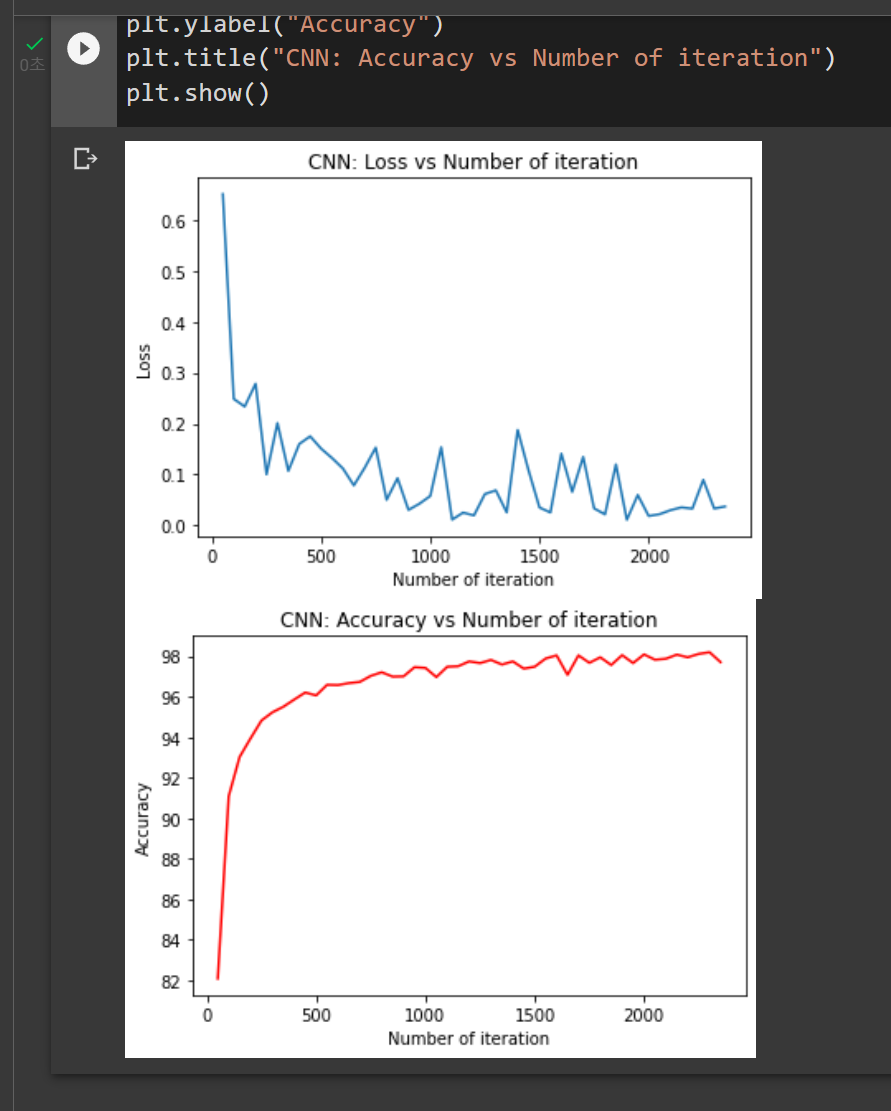철학과 학생의 개발자 도전기
[Pytorch] Pytorch Tutorial - CNN 본문
Convolutional Neural Network (CNN)
- 2층짜리 Convolutional layer를 쌓고, Filter Size는 5*5로 정한다.
- 2층짜리 Pooling layer를 쌓고, 2*2 size의 Max Pooling을 사용한다.
- 마지막에 Fully Connected Layer를 사용한다.
- 자세한 내용은 아래 링크에서 CNN파트를 확인하면 된다.
Pytorch Tutorial for Deep Learning Lovers | Kaggle
Pytorch Tutorial for Deep Learning Lovers
Explore and run machine learning code with Kaggle Notebooks | Using data from Digit Recognizer
www.kaggle.com
import torch
import torch.nn as nn
from torch.autograd import Variable
class CNNModel(nn.Module):
def __init__(self):
super(CNNModel, self).__init__()
# Convolution 1
self.cnn1 = nn.Conv2d(in_channels=1, out_channels=16, kernel_size=5, stride=1, padding=0)
self.relu1 = nn.ReLU()
# Max Pool 1
self.maxpool1 = nn.MaxPool2d(kernel_size=2)
# Convolution 2
self.cnn2 = nn.Conv2d(in_channels=16, out_channels=32, kernel_size=5, stride=1, padding=0)
self.relu2 = nn.ReLU()
# Max Pool 2
self.maxpool2 = nn.MaxPool2d(kernel_size=2)
# Fully conected 1
self.fc1 = nn.Linear(32 * 4 * 4, 10) # 28 -> 24 -> 12 -> 8 -> 4 size
def forward(self, x):
# Convolution 1
out = self.cnn1(x)
out = self.relu1(out)
# Max pool 1
out = self.maxpool1(out)
# Convolution 2
out = self.cnn2(out)
out = self.relu2(out)
# Max pool 2
out = self.maxpool2(out)
# flatten
out = out.view(out.size(0), -1)
# Linear function (readout)
out = self.fc1(out)
return out
# batch_size, epoch and iteration
batch_size = 100
n_iters = 2500
num_epochs = n_iters / (len(features_train) / batch_size)
num_epochs = int(num_epochs)
# Pytorch train and test sets
train = torch.utils.data.TensorDataset(featuresTrain,targetsTrain)
test = torch.utils.data.TensorDataset(featuresTest,targetsTest)
# data loader
train_loader = torch.utils.data.DataLoader(train, batch_size = batch_size, shuffle = False)
test_loader = torch.utils.data.DataLoader(test, batch_size = batch_size, shuffle = False)
# Create CNN
model = CNNModel()
# Cross Entropy Loss
error = nn.CrossEntropyLoss()
# SGD Optimizer
learning_rate = 0.1
optimizer = torch.optim.SGD(model.parameters(), lr=learning_rate)대부분의 내용은 이전 ANN과 동일하다. hidden layer만 2차원 Convolution layer를 사용하면 된다. CNN은 activation function으로 주로 ReLU를 사용한다. 마지막 FC layer에서 input은 32 * 4 * 4이다. 32개의 채널에 feature map size가 4*4인 것이다. input size는 28*28인데 5*5 필터를 가진 Conv layer를 통과하면서 24*24가 되고 2*2 size의 Max pooling을 통해 12*12가 된다. 같은 과정을 반복하면 12 -> 8 -> 4 로 줄어든다.
이제 CNN 학습을 시켜보자.
# CNN model training
count = 0
loss_list = []
iteration_list = []
accuracy_list = []
for epoch in range(num_epochs):
for i, (images, labels) in enumerate(train_loader):
train = Variable(images.view(100,1,28,28))
labels = Variable(labels)
# Clear gradients
optimizer.zero_grad()
# Forward propagation
outputs = model(train)
# Calculate softmax and ross entropy loss
loss = error(outputs, labels)
# Calculating gradients
loss.backward()
# Update parameters
optimizer.step()
count += 1
if count % 50 == 0:
# Calculate Accuracy
correct = 0
total = 0
# Iterate through test dataset
for images, labels in test_loader:
test = Variable(images.view(100,1,28,28))
# Forward propagation
outputs = model(test)
# Get predictions from the maximum value
predicted = torch.max(outputs.data, 1)[1]
# Total number of labels
total += len(labels)
correct += (predicted == labels).sum()
accuracy = 100 * correct / float(total)
# store loss and iteration
loss_list.append(loss.data)
iteration_list.append(count)
accuracy_list.append(accuracy)
if count % 500 == 0:
# Print Loss
print('Iteration: {} Loss: {} Accuracy: {} %'.format(count, loss.data, accuracy))
2000번의 반복만에 98%라는 높은 정확도를 보인다! ANN보다 더 좋은 성능을 보인다. 하지만 학습시간은 훨씬 더 오래 걸렸다.
학습과정을 간단히 시각화하면 다음과 같다.

후기
CNN에 대한 개념적 이해만 있으면 코드로 작성하는 것은 크게 어렵지 않은 것 같다. 기존에 배운 ANN에서 조금씩 수정해주면 되기 때문이다. 사람들이 왜 모델 튜닝보다 데이터 전처리가 더 중요하다고 말하는지 알 것 같다. 데이터 전처리가 훨씬 복잡하고 데이터에 대한 이해도를 필요로 하기 때문인 것 같다. 그렇게 데이터를 잘 가공하면 좋은 알고리즘을 사용해서 괜찮은 성능을 얻을 수 있을 것 같다.
'Pytorch' 카테고리의 다른 글
| [Pytorch] Pytorch Tutorial - ANN (2) | 2022.10.03 |
|---|---|
| [Pytorch] Pytorch Tutorial - Basics of Pytorch (0) | 2022.10.02 |


